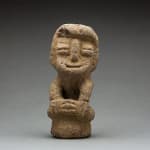Aztec Basalt Figure, 1200 CE - 1450 CE
Basalt
height 18.4 cm
height 7 1/4 in
height 7 1/4 in
SP.550
Further images
The Aztec civilization is perhaps the most celebrated of the ancient Mesoamerican cultures. Their empire stretched throughout northern Mexico and was surpassed in size only by that of the Incans....
The Aztec civilization is perhaps the most celebrated of the ancient Mesoamerican cultures. Their empire stretched throughout northern Mexico and was surpassed in size only by that of the Incans. Tenochtitlan (modern-day Mexico City) was the center of their religious and political systems. The city was composed of a group of island located in the center of Lake Texcoco, earning it the nickname “Venice of the New World.” By the time the Spanish Conquistadors arrived in the early 16th Century, led by the infamous Hernan Cortes, Tenochtitlan was by far larger than any city they could have seen in Europe. Today, the Aztec are remembered for their grand temple complex ruins, for their intricate calendar system, and for the few examples of their art that survive today. Aztec art was primarily ecclesiastical and is renowned for its powerful nature. Highly adept at working with stone, the Aztec artists created artworks that were both grand in scale, as evidenced in their temple architecture, and relatively small in size. Like many cultures, the Aztecs believed that many animals had supernatural symbolic associations. Therefore, although the Aztec gods were usually visualized in human form, most gods also had animal aspects. Moreover, it was believed that both men and gods could, at certain times, actually change themselves into powerful animals.







